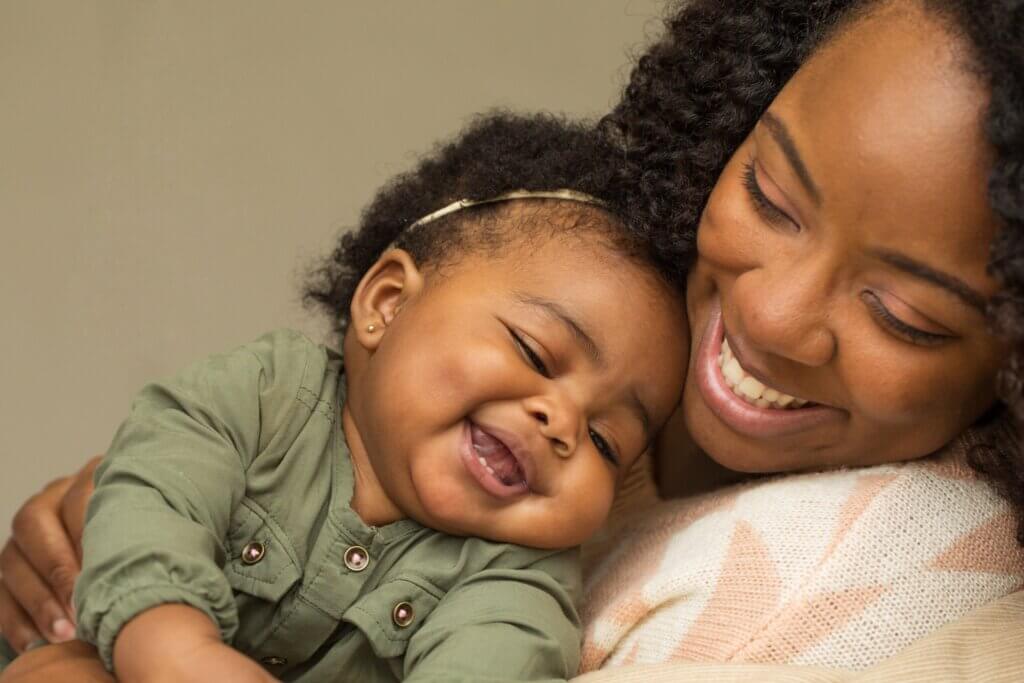Secure Attachment: What It Is and How to Promote It


Escrito y verificado por el psicólogo Gorka Jiménez Pajares
Are your relationships with others healthy? Are you comfortable in relationships that involve intimacy and connection? Does surrounding yourself with meaningful people give you a feeling of well-being? If your answer to these questions is affirmative, it’s likely that you have a way of bonding with others based on secure attachment.
Attachment style refers to two aspects. First, the way we connect with others and, second, the way we treat ourselves. Just like the pages of a book, attachment is the way in which the glue arranges them so that your story can be told. Before talking about secure attachment, we must make some differentiations:
Attachment style is the affective bond that an individual establishes with one or several figures of care and protection. Their biological goal is survival, while their psychological goal is safety.
– Eduardo Fonseca –
What is attachment?
The concept of attachment was born from famous psychiatrist John Bowlby (1982) and famous psychologist Mary Ainsworth (1978) who wondered how mother-son affective bonds were established from an early age. Therefore, they found that it was imprinted in the minds of infants at 12 months of age.
Childhood attachment attempts to explain the effects of early protective bonds on the psychological development of newborns and infants, as well as the consequences of not having them.
– Maria Martina Casullo –
Attachment theory is one of the great scientific productions in the field of personality research. It seems evergreen, as it has survived over time for more than 40 years. Far from being obsolete, new research and studies emerge every day that support and enrich it.
What is bonding style?

According to a study by psychologist Koeneke Hoenicka, a bonding style refers to the ability of parents to transmit to their children that they’re available when they need it. For example:
- Emotional needs. A baby needs its primary figures (parents or another primary caregiver) to transmit love, calm, and warmth. These emotional needs also allude to the act of comfort, for example, when the child cries.
- Care needs. A baby needs sustenance, food that allows it to develop. But also an environment in which to do it. This environment or context can be conducive to its development but it can also be hostile.
- Protection needs. A child needs to feel protected against the vicissitudes of life. In the context of protection, children learn better. For example, knowing that their mother or father will be close if they fall and get a scratch, consequently, it hurts and they cry; This is protective behavior.
- Exploration needs. Children are little adventurers! And this is normal. They need to learn and understand the world around them and when they do so safely, it’s because they feel supported and protected by their main care figure. Exploring the unknown is less hostile when there’s a place to turn for cover if things turn bad.
In this regard, the secure attachment style originates from parents or caregivers who’ve shown themselves to be close and attentive to their baby, as well as available to meet their needs.
Internal operating models
The way in which children learn to “bond” with their primary caregivers in childhood has a lot to do with how they do it in adult life. Why? An explanation can be found in the Internal Working Models.
From the union of the perception of the caregiver’s availability and their emotional receptivity, secure attachment bonds will be born.
– Nuria Martin Ordiales –
These models are implicit patterns of rules that tell us how to relate to other people.
Depending on the ability of parents to satisfy what their children need, as well as what they demand, each infant develops a representation that remains etched in the mind about themself (Am I worthy of affection, care, and attention? Of the people that surround me?) and regarding others (Are the people who say they love me available to give me their affection and care?)
How does this happen? According to psychologist Martín Ordiales (University of Murcia), in three different ways:
- The child can seek, follow, and decide whether to maintain a behavior of proximity to their protective attachment figure.
- Likewise, the child can decide whether to use this protective attachment figure as a “safe base” from which to explore situations that are unfamiliar.
- When danger appears and the child’s consequently alarmed, they may look to their protective attachment figure for “refuge.”
What is secure attachment?
The secure attachment style arises hand in hand with an appropriate education in the earliest childhood. In addition, various investigations have found that this is the most frequent attachment style in all cultures.
Secure attachment is a universal component of human genetic programming that’s expressed through interaction with close relationships and the relational environment.
-John Bowlby-
Individuals who acquire a secure-type attachment style are distinguished by harboring positive beliefs both about themselves and about others. The relationships that these people establish are healthy: They express the closeness of love and friendship while feeling comfortable with intimacy.
When we talk about intimacy, we’re referring to it in terms of “skin to skin” but also “mind to mind” and “soul to soul” with respect to other people. Some characteristics of people with secure attachment are the following:
- They present appropriate behaviors that are in accordance with the values they possess.
- Expectations about others and memories of relationships with other people are good-natured.
- Past friends are remembered with peace and in an integrated way.
These people are far from having problems when it comes to placing their trust in other people. They know how to measure and calibrate well when to trust or when to distrust. In addition, they’re able to find the balance between “I need you” and “I need me”.
In the same way that they turn to other people when they’re unable to solve something, they’re also very autonomous and independent. Consequently, they’re able to function on a day-to-day basis with confidence. They also take responsibility and take charge of the emotions they experience, whether they’re pleasant or unpleasant.
This type of attachment creates a level of neurophysiological homeostasis, the absence of which generates alterations in the nervous system.
– Doris Ortiz-Grania –
How to promote secure attachment?

Securely attached individuals tend to have a lower avoidance and anxiety profile when bonding with others. In consultation, psychotherapists must be clear about some guidelines (Fonseca, 2021):
- Securely attached clients tend to launch more easily into establishing a therapeutic bond with the psychotherapist. They have an easier time compared to others when it comes to recognizing that they need help and, accordingly, asking for it.
- Although they may seem to be simple patients when attending, it’s important that the therapeutic relationship is tended to through metacognitive work.
Ideally, a professional should be the one to evaluate the attachment style of the person who has come to the consultation and, from there, outline a treatment plan from which to build ways to promote secure attachment. However, there are some strategies that can promote it:
- Be coherent between what you think and do.
- Take responsibility for your actions.
- Empathize with your surroundings and try to cooperate with other people.
- If you’re having difficulty establishing intimacy-based bonds, carefully explore how to foster intimacy in your interpersonal relationships.
- Be aware of your needs in regard to emotions and the assertive expression of desires.
- Learn to stop facing situations with avoidance. This is a bitter companion that separates us from the secure attachment style.
- Get hold of various techniques that promote calm! In this regard, breathing techniques can be useful to deal with situations that generate anxiety.
A person with a secure attachment style is able to establish a secure mutual dependency, so that their relationships are more stable and satisfying.
– Doris Ortiz-Grana –
Secure attachment in adults is something that we can all develop, regardless of the attachment style that we begin with. For this, it may be useful to go to a trusted health professional who can provide you with personalized guidelines for your particular case.
Although changing attachment styles is complicated, it’s far from impossible. Secure attachment relationships tend to be healthy relationships. In this regard, we encourage you to do so.
Are your relationships with others healthy? Are you comfortable in relationships that involve intimacy and connection? Does surrounding yourself with meaningful people give you a feeling of well-being? If your answer to these questions is affirmative, it’s likely that you have a way of bonding with others based on secure attachment.
Attachment style refers to two aspects. First, the way we connect with others and, second, the way we treat ourselves. Just like the pages of a book, attachment is the way in which the glue arranges them so that your story can be told. Before talking about secure attachment, we must make some differentiations:
Attachment style is the affective bond that an individual establishes with one or several figures of care and protection. Their biological goal is survival, while their psychological goal is safety.
– Eduardo Fonseca –
What is attachment?
The concept of attachment was born from famous psychiatrist John Bowlby (1982) and famous psychologist Mary Ainsworth (1978) who wondered how mother-son affective bonds were established from an early age. Therefore, they found that it was imprinted in the minds of infants at 12 months of age.
Childhood attachment attempts to explain the effects of early protective bonds on the psychological development of newborns and infants, as well as the consequences of not having them.
– Maria Martina Casullo –
Attachment theory is one of the great scientific productions in the field of personality research. It seems evergreen, as it has survived over time for more than 40 years. Far from being obsolete, new research and studies emerge every day that support and enrich it.
What is bonding style?

According to a study by psychologist Koeneke Hoenicka, a bonding style refers to the ability of parents to transmit to their children that they’re available when they need it. For example:
- Emotional needs. A baby needs its primary figures (parents or another primary caregiver) to transmit love, calm, and warmth. These emotional needs also allude to the act of comfort, for example, when the child cries.
- Care needs. A baby needs sustenance, food that allows it to develop. But also an environment in which to do it. This environment or context can be conducive to its development but it can also be hostile.
- Protection needs. A child needs to feel protected against the vicissitudes of life. In the context of protection, children learn better. For example, knowing that their mother or father will be close if they fall and get a scratch, consequently, it hurts and they cry; This is protective behavior.
- Exploration needs. Children are little adventurers! And this is normal. They need to learn and understand the world around them and when they do so safely, it’s because they feel supported and protected by their main care figure. Exploring the unknown is less hostile when there’s a place to turn for cover if things turn bad.
In this regard, the secure attachment style originates from parents or caregivers who’ve shown themselves to be close and attentive to their baby, as well as available to meet their needs.
Internal operating models
The way in which children learn to “bond” with their primary caregivers in childhood has a lot to do with how they do it in adult life. Why? An explanation can be found in the Internal Working Models.
From the union of the perception of the caregiver’s availability and their emotional receptivity, secure attachment bonds will be born.
– Nuria Martin Ordiales –
These models are implicit patterns of rules that tell us how to relate to other people.
Depending on the ability of parents to satisfy what their children need, as well as what they demand, each infant develops a representation that remains etched in the mind about themself (Am I worthy of affection, care, and attention? Of the people that surround me?) and regarding others (Are the people who say they love me available to give me their affection and care?)
How does this happen? According to psychologist Martín Ordiales (University of Murcia), in three different ways:
- The child can seek, follow, and decide whether to maintain a behavior of proximity to their protective attachment figure.
- Likewise, the child can decide whether to use this protective attachment figure as a “safe base” from which to explore situations that are unfamiliar.
- When danger appears and the child’s consequently alarmed, they may look to their protective attachment figure for “refuge.”
What is secure attachment?
The secure attachment style arises hand in hand with an appropriate education in the earliest childhood. In addition, various investigations have found that this is the most frequent attachment style in all cultures.
Secure attachment is a universal component of human genetic programming that’s expressed through interaction with close relationships and the relational environment.
-John Bowlby-
Individuals who acquire a secure-type attachment style are distinguished by harboring positive beliefs both about themselves and about others. The relationships that these people establish are healthy: They express the closeness of love and friendship while feeling comfortable with intimacy.
When we talk about intimacy, we’re referring to it in terms of “skin to skin” but also “mind to mind” and “soul to soul” with respect to other people. Some characteristics of people with secure attachment are the following:
- They present appropriate behaviors that are in accordance with the values they possess.
- Expectations about others and memories of relationships with other people are good-natured.
- Past friends are remembered with peace and in an integrated way.
These people are far from having problems when it comes to placing their trust in other people. They know how to measure and calibrate well when to trust or when to distrust. In addition, they’re able to find the balance between “I need you” and “I need me”.
In the same way that they turn to other people when they’re unable to solve something, they’re also very autonomous and independent. Consequently, they’re able to function on a day-to-day basis with confidence. They also take responsibility and take charge of the emotions they experience, whether they’re pleasant or unpleasant.
This type of attachment creates a level of neurophysiological homeostasis, the absence of which generates alterations in the nervous system.
– Doris Ortiz-Grania –
How to promote secure attachment?

Securely attached individuals tend to have a lower avoidance and anxiety profile when bonding with others. In consultation, psychotherapists must be clear about some guidelines (Fonseca, 2021):
- Securely attached clients tend to launch more easily into establishing a therapeutic bond with the psychotherapist. They have an easier time compared to others when it comes to recognizing that they need help and, accordingly, asking for it.
- Although they may seem to be simple patients when attending, it’s important that the therapeutic relationship is tended to through metacognitive work.
Ideally, a professional should be the one to evaluate the attachment style of the person who has come to the consultation and, from there, outline a treatment plan from which to build ways to promote secure attachment. However, there are some strategies that can promote it:
- Be coherent between what you think and do.
- Take responsibility for your actions.
- Empathize with your surroundings and try to cooperate with other people.
- If you’re having difficulty establishing intimacy-based bonds, carefully explore how to foster intimacy in your interpersonal relationships.
- Be aware of your needs in regard to emotions and the assertive expression of desires.
- Learn to stop facing situations with avoidance. This is a bitter companion that separates us from the secure attachment style.
- Get hold of various techniques that promote calm! In this regard, breathing techniques can be useful to deal with situations that generate anxiety.
A person with a secure attachment style is able to establish a secure mutual dependency, so that their relationships are more stable and satisfying.
– Doris Ortiz-Grana –
Secure attachment in adults is something that we can all develop, regardless of the attachment style that we begin with. For this, it may be useful to go to a trusted health professional who can provide you with personalized guidelines for your particular case.
Although changing attachment styles is complicated, it’s far from impossible. Secure attachment relationships tend to be healthy relationships. In this regard, we encourage you to do so.
-
Koeneke Hoenicka, M. A. (2022). Relación entre la vinculación con los padres en la infancia y estilo de apego en adultos: un estudio comparativo entre las culturas española, italiana y japonesa.
-
Ordiales, N. M., Chaparro, M. P. M., Rives, N. L. M., & Montesinos, M. D. H. (2022). Variables implicadas en la transmisión intergeneracional del estilo de apego: una revisión sistemática. Revista de Psicología Clínica con Niños y Adolescentes, 9(1), 1.
-
Pedrero, F. E. (2021). Manual de tratamientos psicológicos: Infancia y adolescencia (Psicología) (1.a ed.). Ediciones Pirámide.
-
Mónaco, E., de la Barrera, U., & Montoya-Castilla, I. (2021). La influencia del apego sobre el bienestar en la juventud: el rol mediador de la regulación emocional. Anales de Psicología/Annals of Psychology, 37(1), 21-27.
-
Ortiz-Granja, D., Acosta-Rodas, P., Rubio, D., Lepe-Martínez, N., Del Valle, M., Caden, D., … & Galarza, C. R. (2019). Consideraciones teóricas acerca del apego en adultos. Avances en Psicología, 27(2), 135-152.
-
Casullo, M. M., & Fernández Liporace, M. (2005). Evaluación de los estilos de apego en adultos. Anuario de investigaciones, 12, 183-192.
Este texto se ofrece únicamente con propósitos informativos y no reemplaza la consulta con un profesional. Ante dudas, consulta a tu especialista.







